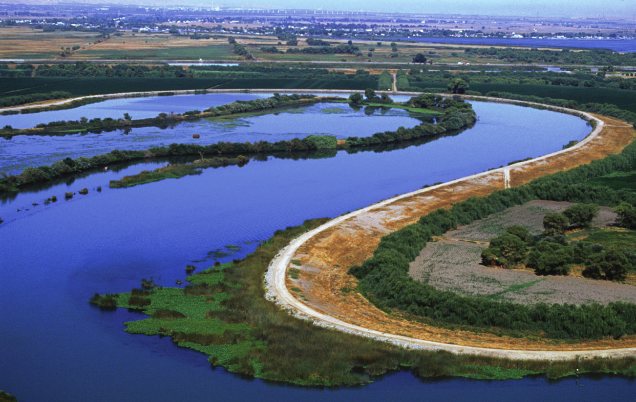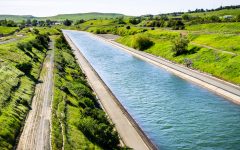
California Bay Delta water (Photo: USGS.gov)
Cleaning Bay Source Pollution Will Enable More Delta Diversions
Financial special interests in California want water scarcity
By Edward Ring, February 27, 2023 3:19 pm
On February 21, the California State Water Resources Control Board waived environmental regulations in order to permit more storage in Central Valley reservoirs. This came a week after Governor Gavin Newsom temporarily suspended environmental laws that prevent reservoir storage if flow through the Sacramento-San Joaquin Delta falls below 58,000 acre feet per day.
A guest opinion piece in the San Francisco Chronicle, published immediately after Newsom’s action, warned of dire consequences. “Newsom just declared war on San Francisco Bay” was its thundering headline, claiming Newsom is waging “a generic war against the realities of California’s hydrology that cannot be won.”
According to environmentalists, the Sacramento-San Joaquin Delta’s “estuarine ecosystem is highly dependent on the amount of fresh water that flows into it from the watershed.” And while this is undoubtedly true, current environmentalist concerns ignore two important facts.
First, flows into the Delta this season have been unusually robust, and will remain so even if more water is reserved for reservoir storage. According to data posted online by the California Department of Water Resources, so far this rain season (10/01/2022 through 2/26/2023), after withdrawals for storage, net flow through the Delta has totaled 8.3 million acre feet (MAF). This is compared to only 3.6 MAF for the same period in 2021-22, 2.0 MAF for the same period in 2020-21, 3.5 MAF in 2019-20, 7.0 MAF in 2018-19, and 3.2 MAF in 2017-18. The last time the Delta’s net flow was greater than it has been so far this year was during the epic storms and flooding of 2016-17, seven years ago.
At the same time, and unlike 2016-17, storms continue to blow into California, and the Sierra snowpack’s water content currently stands at 144 percent of normal in the north, 185 percent of normal in the central Sierra, and an incredible 219 percent of normal in the southern mountains. There is plenty of water this year for everyone; the Delta, other aquatic ecosystems throughout the Sacramento-San Joaquin watershed, the reservoirs, the aquifers, the farms, the cities.
But another critical fact eludes environmentalists who condemn Newsom’s decision to permit more water storage: the role of inadequately treated wastewater causing deadly pollution in the San Francisco Bay. Environmentalists, themselves perhaps failing to recognize “the realities of California’s hydrology,” demand unrealistically high net flows through the Delta and into the Bay in order to dilute and wash out to sea the pollution that should never have entered the Bay to begin with.
The San Francisco Chronicle, back in September 2022 offered clarity on this issue in an article with the unsubtle title “Poop and pee fueled the huge algae bloom in San Francisco Bay. Fixing the problem could cost $14 billion.” The author went on to write “While scientists suspect climate change played a role in triggering the bloom, what fueled it is not a mystery. Algae blooms need food to grow, and this one had plenty: nutrients originating in wastewater that the region’s 37 sewage plants pump into the bay.”
The problems with nutrient pollution in the San Francisco Bay are well known. A 2022 report by the Bay Area Clean Water Agencies (BACWA), after extensive research, estimated the total nutrient rich wastewater discharge into the Bay to average nearly a half-million acre feet per year (figure 4.1, page 15). Nearly all of that water, by the way, is imported from the State Water Project and hence is itself dependent on reservoir storage.
Sources at BACWA confirmed the roughly $14 billion cost estimate to upgrade wastewater treatment in the San Francisco Bay region, but emphasized the complexity of the task. Each treatment plant differs in terms of the chemistry of the wastewater inflow, the technology currently in place to treat it, and the viable options available to upgrade the treatment processes. But here is where environmentalists, if they truly wish to balance the needs of the environment with the needs of civilization, could play a much more productive role.
Instead of continuously fighting for more restrictions on water withdrawals for storage, environmentalists could fight harder to expedite the planning and approval process for upgrades to wastewater treatment plants. They could help by supporting and participating in efforts to secure funding through regional and state bond financings, allocations from state and local government operating budgets, and accessing federal infrastructure funds. As it is, environmentalists often come out of the woodwork to oppose new infrastructure projects, even those that will correct far more problems than they will create.
Several years ago, when co-writing a lengthy report on rebuilding California’s infrastructure, one of the water experts I was collaborating with, who was only temporarily residing in California, made a candid observation. She said “we are taking short showers so giant corporations can grow almonds in the South San Joaquin Valley.”
There’s a lot to unpack in that statement, because it contains more than a grain of truth. But it reflects a mentality that is as seductive as it is paralytic and divisive. Water management in California is incredibly complex, and every time solutions are framed in the language of us-vs-them, nothing gets built. Water markets and more investment in conveyance can resolve any perceived imbalance whereby the biggest agribusiness concerns use up so much water that city dwellers must submit to rationing and ecosystems are compromised. But that solution only works against the backdrop of water abundance, and water abundance can only be achieved when Californians invest in a water infrastructure that is upgraded to meet the requirements of the 21st century.
Environmentalists need to consider the possibility that financial special interests in California, not only including some of the bigger agribusinesses, but even more so investment hedge funds, want water scarcity. They want scarcity to buy up and consolidate distressed farm properties, and as hedge funds, to reap higher returns as the water rights on the land they’ve purchased become more valuable. Environmental protection is not a priority for these investors, it’s a cover story. Are these the special interests with whom environmentalists want to make common cause? Because that’s what’s happening, and not only in the world of water.
It would be helpful to have an honest appraisal of just how much water could be harvested from the Delta during storm seasons if nitrogen pollution in the San Francisco Bay were eliminated. An authoritative report from the Public Policy Research Institute (PPIC) in 2017 included a revealing finding. They estimated “uncaptured water” flowing out of the Delta, in excess of ecosystem requirements, averaged 11.3 MAF per year (ref. page 13) over the 1980-2016 period. To be sure, PPIC pointed out this average included very dry years when there was almost no uncaptured water, and as well that “ecosystem requirements” have been continuously increased.
This trend, continuously increasing requirements for ecosystem water, has farmers and urban water agencies understandably frustrated. But even if that 11.3 MAF estimate of average annual uncaptured Delta flows were cut in half for the sake of ecosystems, it would still represent an additional 5.6 MAF per year of available water that Californians currently lack both the regulatory framework and the physical capacity to safely withdraw and store. That, along with upgrading every urban wastewater treatment plant in the state, ought to be the shared goal of anyone driven to opine on water policy in California – most definitely including environmentalists.
- Ringside: EVs and California’s Future Demand for Electricity - December 4, 2025
- Ringside: Politically Viable Water Supply Projects - November 27, 2025
- Ringside: Shifting Costs Does Not Solve California’s Electricity Shortages - November 20, 2025





If environmentalists were really environmentalists they would support upgrading sewer plants. The reality is that the “environmentalists” currently running things don’t care at all about the environment. Their job as they see it is to destroy humanity by taking away all their resources. Energy, water, food and jobs are at the top of their list.
Not only hedge funds, but probably CCP related companies want water scarcity in order to buy up and consolidate distressed farm properties? Gov. Newsom, Senator Dianne Feinstein, Congresman Eric Salwell, and other California Democrats seem to have had cozy relationships with the CCP?
It’s valuable to have Edward Ring’s water policy on the record, even when we cynically and reflexively can’t help thinking that in our current mess it will never be adopted. One day, if we’re lucky, we will have more sensible leadership and these policies will be adopted, even if we sometimes suspect most of us will not be alive to see it. Sigh.
For me the kernel and best insight in this article was the observation that environmentalists may want to re-think aligning themselves with “corporate” agribusiness and hedge funds, both of whom have their own financial reasons for wanting water scarcity. That was a new one for me! — although for others maybe it was only hidden in plain sight — and I can’t help wishing the observation would ‘go viral.’
Katy Grimes has written several columns about how over half the water from rain and snow melt in the state is allowed to flow out to the Pacific Ocean. No doubt that fact will never appease rabid environmentalists who would probably like to have 100 percent of the water flowing out to sea? The Democrat cabal that controls the state would probably go along with that since they want permanent water scarcity to further oppress and control Californians?
Why hasn’t the Los Angeles “flood control system” been overhauled to capture, treat and save the BILLIONS of gallons of rainwater that run out to the ocean to pollute Santa Monica Bay for at least 5-7 days after every heavy rainfall???
Why don’t the “conservationist environmentalists” agitate for THAT??
One reasonable core question (in the midst of a lot of imprecise thinking, pseudoscience, and paranoia) is: how much water would be saved if the wastewater pollution were cleaned up?
The answer is zero, because the endpoint of water management in the Delta is not pollution dilution. Rather, flow controls and regulations function are calculated to control the impacts of salinity intrusion in the Delta. The premise that cleaning up the bay would free up resources is false.
That said, its still a great idea to clean up the wastewater discharges because bay-wide algae blooms are disgusting.